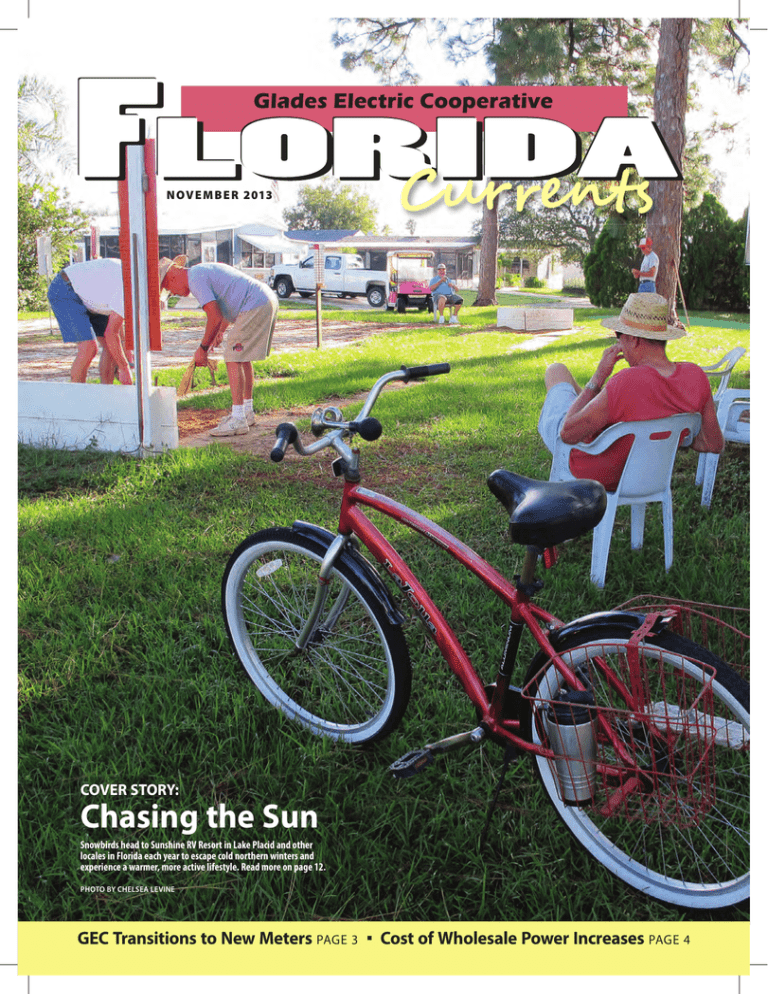
Glades Electric Cooperative
N OV E M B E R 2013
COVER STORY:
Chasing the Sun
Snowbirds head to Sunshine RV Resort in Lake Placid and other
locales in Florida each year to escape cold northern winters and
experience a warmer, more active lifestyle. Read more on page 12.
PHOTO BY CHELSEA LEVINE
GEC Transitions to New Meters PAGE 3
Cost of Wholesale Power Increases PAGE 4
Glades Electric
Neighbors Working for Neighbors
GEC Transitions to New Meters
Members acknowledge that $3.96, plus
actual postage, is the cost to publish
12 issues a year of Florida Currents
(USPS-8300). Published by Ruralite
Services Inc., 2040 A St., Forest Grove,
OR 97116—a not-for-profit Oregon
cooperative corporation—the
magazine serves the communications
needs of consumer-owned electric
utilities in Florida. Preferred Periodicals
postage paid at Forest Grove, OR 97116
and at additional mailing offices.
Postmaster: Please send address
corrections to P.O. Box 558, Forest
Grove, OR 97116.
HOW TO CONTACT FLORIDA CURRENTS
Have a problem receiving your
edition of Florida Currents? Utility
members should contact the local
utility office listed on the back cover.
Nonmembers should contact Ruralite
Services, P.O. Box 558, Forest Grove, OR
97116-0558; (503) 357-2105; email
info@floridacurrents.com.
Subscription services: Nonmember
subscriptions $12 (US) per year; $25
(foreign) per year. Prepayment
required. Allow 4 to 8 weeks for first
issue. Be sure to identify which local
edition you want to receive.
Extra copies: $2 each, pre-payment
required. Supply is limited. Identify
edition, month and year. Contact
Ruralite Services.
Reprint permission: Direct all requests
to Ruralite Services.
MANUSCRIPTS AND PHOTOGRAPHS
Please do not send unsolicited
materials. If interested in writing for
Florida Currents, query first. Include a
self-addressed stamped envelope for
writer’s guidelines. Address requests
and queries to Ruralite Services.
DISPLAY ADVERTISING INQUIRIES
Contact Jessah Willis
National Country Market
611 S. Congress Ave. Suite 504
Austin, TX 98704
(800) 626-1181 or (512) 441-5200
www.nationalcountrymarket.com
PRINTED IN FLORIDA
Trend Offset Printing Services
10301 Busch Drive North
Jacksonville, FL 32218
© 2013 Ruralite Services Inc. All rights
reserved. Reproduction in whole or in
part without written permission is
prohibited.
Preparations have
begun at Glades Electric
Cooperative to transition to new power
line carrier automated
meters. The new meters
will improve the reliability and efficiency of the
existing electric distribution system.
The advanced metering infrastructure system
uses two-way digital
communication through power lines between
GEC and its meters. Among the many benefits
the new system will bring to members are:
• Faster response to outages.
• More efficient power distribution to help
GEC keep costs from rising for members.
• Improved power quality.
• More accurate information about outages
and restoration times.
• More information for members about
their power use.
• Quicker connection and disconnection
times.
• Better detection of power theft.
GEC will begin installing the new meters
in the coming months and anticipates using
the new functions of the meters beginning
in the spring of 2014.
GEC expects the transition for all meters to be
spread throughout at
least 24 months.
“The impact of the
installation is minimal
and the benefits are
countless,” said Director
of Member Services
Margaret Ellerbee. “We
are excited to be able to
provide improved services such as more flexible billing options for
members.”
Members can expect to lose power for a few
minutes on the day of the installation. The new
meters will not affect the kilowatt-hour rate
members pay.
“The co-op anticipates that labor and cost
savings from the program will allow the utility
to recoup the investment quickly,” explained
CEO Jeff Brewington. “The new technology
will greatly improve our efficiency and reliability, while allowing us to provide additional services not previously available to our members.”
Look for more information regarding the
AMI system in the coming months in Florida
Currents, at www.gladesec.com and on GEC’s
Facebook page.
Inside
November 2013
Vol. 3, No. 1
Chasing the Sun 12
Snowbirds head south to Florida to
escape cold winter weather and
experience a warm lifestyle.
Also In This Issue
Side Roads 10
In the Kitchen 16
Florida Gardener 18
Festival Roundup 22
Outdoor Pursuits 24
Parting Shot 30
Your utility pages: 4, 5, 6, 7, 8, 25, 26, 28, 29, 32
NOVEMBER 2013
3
Glades Electric
Neighbors Working for Neighbors
The Price
of Power
Seminole Electric Cooperative announces
wholesale power rates for 2014
Glades Electric Cooperative works in partnership with Seminole
Electric Cooperative to supply you with power when you need it
at the most cost-effective rate. Beginning in January, Seminole’s
wholesale cost of electricity will increase 4.2 percent.
Wholesale power refers to the energy and capacity costs
associated with generating electricity, which comprises about 70
percent of your electric bill.
Although a rate increase during tight economic times is not
ideal, Seminole has worked to keep the wholesale cost of power as
low as possible. Its overall percentage increase is less than Florida
Power and Light, Duke Energy Florida and Tampa Electric.
Why is the cost of Seminole’s power going up in 2014? One of
the main reasons is excess capacity. Seminole has more electricity
Seminole Electric Cooperative is one of the largest generation
and transmission cooperatives in the country. Headquartered
in Tampa, its mission is to provide reliable, competitively
priced wholesale electric power to its 10 members, which
include four of the largest distribution cooperatives in the
United States. Seminole owns and operates a 1,300-megawatt
coal-fired power plant in Putnam County and an 810-MW
natural gas power plant on the Polk/Hardee county border.
Additionally, 6 percent of Seminole’s member energy sales
come from renewable sources such as biomass, landfill gas
and municipal solid waste. About 1.7 million people and
businesses in parts of 45 Florida counties rely on Seminole
member distribution cooperatives for electricity.
4
n o v em b e r 2 0 1 3 than it needs through 2016 due to lower population growth and
decreased energy consumption. Annual growth for electric cooperatives in Florida historically increased an average of 4 percent
a year. However, in 2006, the U.S. housing market took a massive
and unexpected drop, leaving many homes unsold and vacant
from repossessions and foreclosures.
For Seminole, the annual growth rate declined to nearly zero.
Plans that had to be put in place in advance of the expected
growth resulted in a surplus of capacity. At the same time, consumer spending dropped, and people started using less electricity
to save money, compounding the problem. Seminole, GEC and
other utilities in the state could not have predicted the dramatic
and unexpected shift in Florida’s load, growth and consumer use.
Additional factors affecting the wholesale rate include increases
in the costs of coal and natural gas, and expiring contracts for
Seminole to buy electricity beyond what it is able to generate.
Seminole supplies about 50 percent of its member energy
needs through self-owned generation: 1,300 megawatts from
its coal-fired facility and 810 MW from its natural gas plant.
However, on any given day, depending on weather or demand,
members may need more energy than what Seminole can generate. Therefore, Seminole buys energy from investor-owned
utilities and merchant energy providers, securing short-,
medium- and long-term contracts to complete its supply of
EPA Rules Could Affect Semiole Facilities
The natural gas-fired Midulla plant on the Polk-Hardee county border produces
810 megawatts for Seminole Electric Cooperative. The generation and transmission cooperative provides wholesale power to Glades Electric Cooperative.
Photo courtesy of Seminole Electric Cooperative
energy to meet members’ needs now and into the future.
These purchase power agreements—which are more cost
effective than building additional generating plants—include
more than 6 percent of renewable generation. That gives
Seminole one of the state’s largest renewable energy portfolios.
As older, existing purchase power agreements expire, Seminole
must replace them with new contracts, usually priced higher.
Seminole has worked to mitigate the wholesale rate increase by
restructuring existing purchase contracts, where possible; deferring the addition of new power generation to its portfolio; and
implementing cost-cutting measures at its facilities. Seminole
staff is working to improve operational efficiency through better
technology and reduce costs associated with maintenance.
Although the road to economic recovery is slow, growth in
Florida is beginning to increase. Because Seminole and GEC
are not-for-profit electric cooperatives, the only way to recover
the cost of buying and supplying power to you is to pass on
those costs. As demand begins to rise, Seminole and GEC
remain dedicated to meeting future power needs, while providing affordable and reliable electricity.
on September 20, 2013, the U.S. Environmental Protection
Agency proposed its revised rule issuing New Source
Performance Standards for carbon dioxide emissions from new
coal- or natural gas-fired electric generating units.
In the revised rule, the EPA proposes carbon limits for
any new natural gas- or coal-fired power plant that sells
more than one-third of its output to the electric grid. The
standard for new coal plants is so stringent it will require
utilities to capture approximately 50 percent of the carbon
dioxide they could emit. Therefore, new coal-fired units
would have to install costly carbon capture and sequestration
(CCS) technology. While EPA contends CCS is commercially
available and economically viable, there are no full-scale CCS
systems operating on any coal-burning power plants.
Seminole Electric Cooperative uses a variety of generation
resources, including coal, natural gas and renewable energy.
because this rule does not apply to existing sources, it does
not have any immediate impact on Seminole’s natural gasand coal-fired power plants. Any new fossil-fuel generation
would have to meet the emission standards when finalized
by the EPA. by requiring unproven and costly CCS technology,
the proposed rule would make coal an uneconomic choice to
meet Seminole members’ future needs.
In June 2014, the EPA is scheduled to release its rule
addressing carbon emissions from existing sources. The
existing source rulemaking will be far more significant to
Seminole, which relies on coal for about half of the energy its
members need. Seminole completed construction of its coal
units in the early 1980s. This was a time, following the first
oPEC oil embargo, when Congress disallowed the continued
use of natural gas for power generation and required new
power plants to use coal as the primary fuel source.
Seminole has invested more than $530 million in environmental pollution controls, making its coal-fired generating
facility one of the cleanest power plants in the country.
Seminole’s mission is to keep electric bills affordable, while
providing members the power they need to improve their
quality of life. Seminole supports using a diverse fuel mix
to generate electricity, including renewables, natural gas
and coal. Seminole will join with electric cooperatives from
around the country to fight any proposals that will adversely
affect the cost and the reliability of energy to our members.
For more information, please visit www.seminole-electric.
com or www.action.coop.
NovEMbEr 2013
5
Glades Electric
Neighbors Working for Neighbors
Gadgets That Get You Going
By Mike Teegarden
We know our readers are active, not content to sit
on the couch and read about other people’s adventures. Take a short break from your busy summer
and check out some of these hip gadgets that will
help you better enjoy an active lifestyle.
BioLite Camp Stove
Cook your meals using the BioLite Camp Stove
(shown above) with nothing more than a few twigs
and fir cones collected on your journey. This stove
cooks using organic materials so there are no heavy,
smelly, polluting fuels to carry.
6
november 2013
The stove weighs 33 ounces, and Biolite says it
can boil one liter of water in about 41/2 minutes.
While that water is boiling, a device in the stove
converts heat to electricity, powering an internal fan
that boosts the efficiency of the fire. Excess electricity is sent to a USB port, where any USB-capable
device can be charged.
Not just for campers, this stove is a perfect addition to an emergency kit. If the power goes out,
grab some dry debris, head out to the deck and start
cooking. While dinner is cooking, enjoy music from
your mp3 player while it charges.
$129.95—Available at www.biolitestove.com.
ThermaCell Heated Insoles
Keep those tootsies warm and toasty on cold winter outings with ThermaCell heated insoles. A
small rechargeable battery
hidden in each insole eliminates the need for wires. A
wireless remote allows you
to change the setting from
medium (100 F), high
(110 F) to off. Each
charge provides
up to five hours
of continuous heat,
or extend
the time
by turning the units
off and on as needed. Batteries are good for 500
charges.
ThermaCell insoles are water resistant and can be
used in boots, shoes and waders. They will fit any
shoe from a woman’s 6 to a man’s 13.
$129.99—www.thermacell.com
emiting diods that provide light for 20 hours at full
power.
The batteries will recharge in about eight hours
of sunshine or in five hours by plugging into a powered USB port. The unit can recharge most smart
phones in about two hours.
$79—www.waka-waka.com
A Bright Idea
The founders at ilumi believe they have invented the
world’s smartest light bulb. Using LED technology
combined with bluetooth capability, their bulbs may
change the way we interact with our home lighting. Combined with a smartphone app, the ilumi
LED bulb can change color and intensity based on
a number of factors. The ilumi app can make the
lights flash when your cell phone rings, change colors with music you play, or turn on and off as you
walk past.
$98/$88—www.ilumisolutions.com
WakaWaka Power
During a prolonged power outage, not being able
to charge the portable electronic devices we rely
on daily can be frustrating. WakaWaka Power
can solve that problem. WakaWaka means “shine
bright” in Swahili. Using a solar panel to charge
its 2,200 mAh LiPo batteries, the WakaWaka
Power unit can charge any USB-capable device.
The WakaWaka Power unit also has a pair of light
Mad Science
relax at the
end of your
busy day with
mad Science,
edited by
randy Alfred.
Published
by the folks
at Wired
magazine, this
book explores
the genesis of
many of the
technologies
we take for
granted today.
Who invented
the Xerox
machine? The
band-Aid? The
container ship?
What about
the traffic
signal and
the shopping
cart, or the
transistor and
the microchip?
$13.88—www.
amazon.com
Belkin Mini Surge Suppressor and USB Plug
The Belkin BT300 lets you safely plug
your electronic devices anywhere while
you travel It features a 900-Joule energy
rating, providing power protection for
all your sensitive mobile devices.
It has two powered USB ports
(2.1 amp combined) for charging your tablets, smartphones and
other mobile devices. It has wallmountable for three extra AC outlets without extra cords, and has
a 360-degree rotating plug with
four locking positions.
$29.99—www.amazon.com
November 2013
7
Glades Electric
Neighbors Working for Neighbors
Operation Round Up Monthly Report
Charitable
Trust Board
of Directors
Barbara Hughes
District 1
Moore Haven
Beverly Eaves
District 2
Hendry County
Kelly Brantley
District 3
Ortona/Palmdale
Dori Evans
District 4
Lakeport
Lori Thompson
District 5
Venus/Hicora
Lee Andrus
District 6
Highlands Park
Jerry Chasteen
District 7
Lorida
David McCadam
District 8
Lake Josephine
Angela Hodges
District 9
Okeechobee
The next meeting of
the Charitable Trust
Board of Directors is
1 p.m. November 26
in Moore Haven.
8
NOVEMBER 2013
More than 72 percent of Glades Electric Cooperative
members participate in Operation Round Up.
This program helps people in GEC’s service area
who have exhausted normal avenues of financial
assistance. Sign up today, and your electric bill will
be rounded up to the nearest dollar. The extra is
placed in the fund for deserving individuals and
organizations.
As of October 9, your Charitable Trust Board of
Directors has approved $800,233.18 in disbursements. These funds have provided assistance with
food, emergency lodging, disaster relief and specific
emergency needs for 526 individuals and/or families
and 105 community organizations.
The trust does not fund utility bills (electric,
phone, water and gas) or budgets of organizations.
Organizations in our service counties may apply for
funding for a specific need or project.
The Charitable Trust Board of Directors meets
monthly to review applications for funding.
If you know of people who need and deserve assistance and live
within our service area, encourage or help them to complete an
application. Applications can be picked up at each of our three
offices: Moore Haven, Lake Placid and Okeechobee.
GEC Needs Your Help to Update Our Upgrade
Glades Electric Cooperative’s phone system has been upgraded to make it easier
for members to make payments and report outages. Members who have the
most current contact information in our system will benefit the most. Please call
a member services representative at (800) 226-4024 to make sure your contact
information is current.
$25
Credit
Winners
Nicholas Dangelo
No. 18210-001
Shirley Eaton
No. 100896-001
Winners should call (800)
226-4024 or sign their name
on this page and mail it to:
Florida Currents $25 Credit
Glades Electric Cooperative
P.O. Box 519
Moore Haven, FL 33471
Church of the Month
Lakeport Christian Church
10947 East State Road 78
Moore Haven, FL 33471-5068
Glades Electric
Neighbors Working for Neighbors
Control Your Holiday Cooking Costs
The U.S. Department of Energy estimates
cooking accounts for 4 percent of home
energy use. This figure does not include
energy costs associated with refrigeration,
water heating and dishwashing.
As holiday parties and potlucks gear
up, DOE suggests you keep these tips in
mind to control energy costs:
• Don’t peek. Every time the oven
door is opened, the temperature inside is
reduced by as much as 25 degrees, forcing the oven to use more energy to get
back to the proper cooking temperature.
• Turn it down or turn it off. For
regular cooking, it probably is not necessary to have your oven on as long—or
set as high—as the recipe says. For recipes that need to bake for longer than
an hour, preheating the oven is not
necessary. And residual heat from an
electric oven or stovetop will finish the
last 5 to 10 minutes of cooking time. Just
remember to keep the oven door closed
or the lid on until time is up. Alternately,
if you are baking in a ceramic or glass
dish, you typically can set your oven
for 25 degrees less than the recipe says.
Because ceramic and glass hold heat better than metal pans, your dish will cook
just as well at a lower temperature.
• Give your burners a break. For
your stovetop to function effectively, it
is important the metal reflectors under
your electric burners be free of dirt and
grime.
• Don’t neglect your slowcooker,
microwave, toaster oven or warming plate. The average toaster oven can
use up to half the energy of the average
electric stove in the same cooking time.
Information to help you estimate how
much energy your appliances use is available at www.energysavers.gov.
• Give your furnace the day off. If
your next party involves a lot work for
your stove, think about turning down
your furnace to compensate. The heat of
the oven and all those guests will keep
the temperature comfortable.
• Make contact. Heat can be transmitted only to pans in direct contact with
electric stovetops; the less contact your
pan has with the burner, the more energy
the stovetop must expend to heat the
pan. If cooking with your warped pan is
taking longer than it should, it may be
time for a flat-bottomed update.
Happy Thanksgiving
From
Your Glades Electric Cooperative Family
NOVEMBER 2013
25
Glades Electric
Neighbors Working for Neighbors
Preventing ‘Cyber-tage’
Electric co-ops are
taking the lead
in protecting the
nation’s electric grid
from cyber attacks
By Jo Ann Emerson
26
november 2013
Security of the nation’s electric grid has
helping the North American Electric Reliability
received a lot of attention lately. Reports of
Corporation—the nation’s grid watchdog—
high-profile hacking attempts on electriwrite Critical Infrastructure Protection stancal facilities by parties foreign and domesdards, the Cooperative Research Network—the
tic, mischievous and nefarious, keep making
research and development arm of the National
front-page news. In fact, according to the U.S.
Rural Electric Cooperative Association—has
Department of Homeland Security,
developed the Guide to Developing
the energy sector was the target of
a Cyber Security and Risk
more than 40 percent of all reported
Mitigation Plan.
cyber attacks last year.
This document, touted by the
In today’s heightened political
U.S. Department of Energy as a
landscape, some have suggested that
prime example for other utilities to
onerous government mandates—as
follow—and endorsed by the head
opposed to our existing system that
of grid security at IBM—provides
provides flexibility to meet evera set of scalable, online tools that
evolving threats—are necessary
can help electric co-ops strengthen
to protect the electric grid from
their cyber-security posture.
cyber assaults. But it’s not certain
As perhaps the first approach
more regulations will make us safer. Jo Ann Emerson
to advancing cyber security at
Consider these points:
the distribution level, the Guide
• Government mandates can’t keep pace to Developing a Cyber Security and Risk
with innovation. Utilities, such as electric
Mitigation Plan ties into the innate co-op sense
cooperatives, are always deploying new techof member responsibility and commitment to
nology—and so are cyber criminals and terror- continuous improvement.
ists. By their very nature, top-down mandates
While no one suggests it will prevent every
will only address known dangers. Such a compossible act of “cyber-tage,” any step at mitigamand-and-control approach means we will
tion means a significant leap toward bolstered
always be fighting yesterday’s battle.
cyber security. As a result, NRECA has offered
• “Gold-plated” cyber-security measures the guide and template to others in the electric
are not the answer. It is possible to build a car utility industry free of charge.
that will survive any crash. But the cost of such
The bottom line is that the past few years,
a vehicle would be astronomical. Utilities need
the North American electric grid has become
the latitude to balance risk and cost for the
more secure because of joint NERC-industry
good of the consumer.
efforts. On the executive-branch level, NRECA
• Compliance is not a deterrent. For
has discussed co-op leadership and concerns
some, federal rules create a false sense of wellsurrounding this subject in meetings with
being. The reasoning goes like this: “If I’m folPresident Barack Obama and U.S. Energy
lowing all of the cyber-security regulations that Secretary Ernest Moniz.
apply to me, then my system must be secure.”
The perils posed by cyber attacks are real.
However, bureaucracy cannot promulgate pro- But thanks to CRN and standards fashioned
cesses that address every contingency. And
by electric utilities under the current voluntary,
any complacency opens the door to a possible
collaborative NERC framework, electric coopcyber strike.
eratives will be better armed to defend against
Fortunately, America’s electric cooperatives
any cyber menace. n
have taken a lead role on this issue. In addition Jo Ann Emerson is CEO of the National Rural Electric
to thousands of hours spent by electric co-ops
Cooperative Association.
Glades Electric
Neighbors Working for Neighbors
Co-op Lighting Lessons
2014 brings brighter efficiency standards and savings
By Amber Bentley
As federal efficiency standards phase out traditional
incandescent light bulbs, electric co-ops are testing
what lighting technologies work best for consumers.
Co-ops have long championed compact fluorescent
lamps—the first cost-effective, energy-saving alternative to traditional bulbs.
“We see them as a quick, low-cost way our members can start saving on their electric bills,” says
Kotzebue Electric General Manager Brad Reeve.
By 2014, household light bulbs using 40 watts to
100 watts will need to consume at least 28 percent
less energy than traditional incandescents. Because
incandescents use 90 percent of their energy producing heat, upgrading saves Americans an estimated $6
billion to $10 billion in lighting costs every year.
More lighting changes will roll out in coming
years. The federal Energy Independence and Security
Act of 2007 requires that light bulbs become
70 percent more efficient than classic bulbs
by 2020. LEDs already exceed this goal.
Lighting accounts for roughly 13 percent of an average household’s electric bill.
Hardware
store
shelves
are
New incandescent bulbs
are at least 28 percent
more efficient than traditional bulbs.
28
NOVEMBER 2013
filled with light bulb options. What works best for
co-op members?
Electric co-ops teamed up on light bulb testing
with the Cooperative Research Network—the research
and development arm of the National Rural Electric
Cooperative Association, an Arlington, Virginia-based
service organization for the nation’s 900-plus consumer-owned, not-for-profit electric co-ops.
“We found most residential consumers still prefer
to use CFLs over more expensive, but more energy
efficient, LEDs,” says Brian Sloboda, CRN senior
program manager specializing in energy efficiency.
“The price of LEDs for home use has substantially
dropped, so we may begin to see more LEDs as it
becomes more economically feasible to buy them.”
A helpful addition to lighting products is the lighting facts label. Much like nutrition labels found on
the back of food packages, this version shows a bulb’s
brightness, appearance, life span and estimated yearly
cost. It was created by the U.S. Department of Energy
to help consumers understand the product and buy
the most efficient light bulb.
Consumers’ energy-efficient lighting options
include:
• Halogen incandescents. Use 25 percent less
energy, and last three times longer than regular
incandescent bulbs.
• CFLs. Use 75 percent less energy, and last up
to 10 times longer.
Light Output
LEDs
CFLs
Incandescents
Lumens
Watts
Watts
Watts
450
4-5
8 - 12
40
300 - 900
6-8
13 - 18
60
1100 - 1300
9 - 13
18 - 22
75 - 100
1600 - 1800
16 - 20
23 - 30
100
2600 - 2800
25 - 28
30 - 55
150
Top, a selection of bulbs
that comply with
lighting regulations
that went into effect in
2012. It includes CFLs,
LEDs and energy-saving
incandescents.
Right, this lighting
facts label helps
consumers make good
choices about their
lighting products.
• LEDs. Use between 75 and 80 percent less
energy, and last up to 25 times longer.
Federal light bulb standards have the potential to
save consumers billions of dollars each year. For an
average American house with about 40 light fixtures,
changing just 15 bulbs can save about $50 a year per
household, according to DOE.
A word of warning when buying new types of
bulbs: You generally get what you pay for.
“Some manufacturers exaggerate claims of energy
savings and life spans, and cheaper models probably
won’t last as long as higher-quality bulbs,” Brian says.
“If you look for the Energy Star label, that means
the bulb exceeds minimum efficiency standards as
tested by the federal government.”
The best way to benefit from this fast-changing
technology is to buy a more energy-efficient light
bulb the next time one goes out, Brian says.
To learn about lighting options, visit www.energysavers.gov/
lighting. For shopping tips, visit www.ftc.gov/light bulbs.
Amber Bentley writes on consumer and cooperative affairs
for Touchstone Energy, the national branding campaign
for more than 740 electric cooperatives.
App Calculates Energy Savings
By Michael W. Kahn, Electric Cooperative Today Staff Writer
How much can you save using CFLs? What does it cost to run the
dishwasher for an hour? Answering those questions is easy with the
Touchstone Energy app, available free for Apple and Android phones.
It is called Together We Save—Save Energy Save Money, an offshoot of
the popular Together We Save program.
“It has two new calculators,” says Jason McGrade, senior web
development and social media specialist at Touchstone Energy.
One allows you to compare incandescent bulbs to CFLs and LEDs, based
on the number of bulbs, the wattage and how many hours they are used
per day. For example, a house with a dozen 75-watt bulbs running eight
hours a day could save $223.70 a year by switching to CFLs,
or $255.65 by converting to LEDs. Daily and monthly
savings also are displayed.
There is also an appliance calculator.
“We’ve got it broken out into different appliances in
different rooms of a house,” says Jason.
Click on “Laundry,” then “Clothes Washer,” and
select the number of hours it runs per month. The
calculator will show what it costs to run per hour and
per month.
“All of the rates are customizable to a local
cooperative,” says Jason. “When the app is
downloaded, enter your zip code and a list of
nearby co-ops appears. Simply select yours. The
plan is to add additional calculators throughout the
year, so we’ll have a full suite.”
The app also pulls in alerts for weather, news “or anything that the
cooperative wants to make their consumer-members aware of,” Jason says.
Members can select the frequency they want to receive alerts, ranging
from real-time to not at all.
NOVEMBER 2013
29
Offices
Open 7 a.m. to 6 p.m. Monday through Thursday
26733 U.S. Hwy. 27 East/P.O. Box 519
Moore Haven, FL 33471
(800) 226-4024 or (863) 946-6200
Fax: (863) 946-2150
214 SR 70 West
Lake Placid, FL 33852
(800) 226-4025 or (863) 531-5000
111 SW Park St.
Okeechobee, FL 34974
(800) 226-4023 or (863) 467-5111
Power Interruption Number
Moore Haven..............................(800) 226-4024
Phones are answered 24 hours a day, seven
days a week, including weekends and holidays.
Please have your location or account number
handy when you call.
Board of Trustees
John “Jack” Coxe, President, District 8
Lake Josephine, (863) 655-3056
James “Jim” Aul, Vice President, District 7
Lorida, (863) 441-0441
Russell Henderson, Sec./Treas., District 3
Ortona and Palmdale, (863) 946-0865
Donnie Lundy, Trustee, District 1
Moore Haven, (863) 946-0402
Barney Goodman, Trustee, District 2
Hendry County, (863) 983-7324
Shannon Hall, Trustee, District 4
Lakeport and Brighton, (863) 946-3242
Ladd Bass, Trustee, District 5
Venus and Hicoria, (863) 441-2227
Lee Henderson, Trustee, District 6
Highlands Park, (863) 633-9281
Irene Lofton, Trustee, District 9
Okeechobee, (863) 467-1219
The next meeting of the Board will be at 9 a.m.
November 26 at the Moore Haven headquarters office. Any changes to this schedule will be
posted in the lobby of all three district offices.
Executive Staff
CEO Jeff Brewington
CFO Jennifer Manning
Dir. of Business Development Paul McGehee
Dir. of Employee Services Yvonne Bradley
Dir. of Information Technologies Bradley Hill
Dir. of Member Services Margaret Ellerbee
Dir. of Operations Tracy Vaughn
32
n ovember 20 1 3 FL-153
CEO’s Message
President’s ‘All-But-One’
Energy Policy Troubling
By the time you receive this publication, if you were not already
aware through our Facebook and website posting, most of you
have noticed the increase in our wholesale power cost adjustment. Although this will amount to a little more than $4 a
month for our typical member account—which concerns me
very much—I am much more concerned about our current
presidential administration’s “All-But-One” energy policy and
what it will do to our power costs. This policy basically leads
to the elimination of coal-fired power plants—one of the least
expensive methods to produce electric energy. It is also the
method Seminole Electric Cooperative, our power provider,
uses to produce 52 percent of its electricity.
The All-But-One policy assures no new coal plants will be
built. More concerning for us is what’s next for existing coal
plants like Seminole’s. New regulations being tossed about for
currently operating coal-fired power plants could add upwards
of $100 a month to each of your accounts. That is outrageous
and unnecessary.
Seminole’s coal plant had an initial cost of $900 million,
which included $250 million of pollution control equipment.
Since that time, an additional $280 million of pollution controls have been added, so 45 percent of the $1.18 billion plant is
composed of pollution control equipment. Seminole’s coal plant
is one of the cleanest operations in the nation, if not the world.
I might add it was built at a time when our national government would only allow the construction of coal-fired plants,
and now they want to cost us out of existence.
I implore you to check out our website, www.gladesec.com,
or our Facebook page for more information on these troubling
matters. Please take action.
On another matter for our members in the Lake Josephine
area, Duke Energy will be making some transmission line
upgrades this month, which will cause two outages on our system. As I write, the outages are scheduled for November 8 and
November 15. Duke anticipates a four-hour outage to complete
the work on both nights. The outages should start just before
midnight. Continue to check our website and Facebook pages
for further updates.
Jeff Brewington





